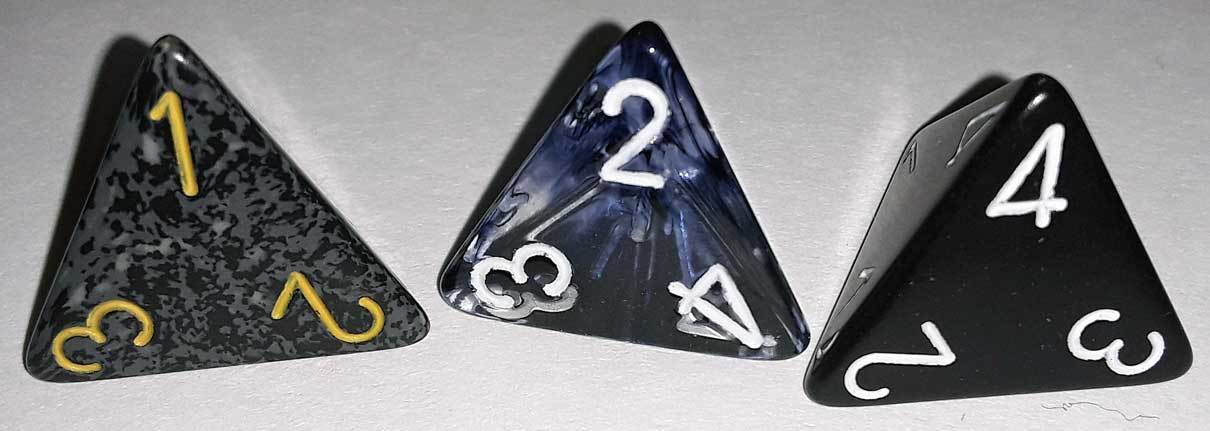Rolling 4-sided fair die with faces numbered 1 to 4. Comparison of standard deviations.
This problem's question: What is the ratio of the standard deviation of rolling three such dice and selecting the second highest value and the standard deviation of rolling just one die?

For this problem, imagine rolling these three dice.
The procedure to determine the second highest value is to sort the rolled values into descending order and then select the second value in the list. This means that the selected value may, in fact, duplicate the highest value rolled. This is, nonetheless, the correct selection.
Compute the standard deviations of the second highest die and of just using the black and white die.
Write the answer as ⌊ StandardDeviation [ t1 ] 1 0 0 StandardDeviation [ t3 ] ⌋ , where ⌊ ⋅ ⌋ is the floor or truncate-to-integer function, t1 is the result of rolling one die (the black and white in this case) and t3 is the result of rolling 3 dice and selecting the second highest..
The answer is 73.
This section requires Javascript.
You are seeing this because something didn't load right. We suggest you, (a) try
refreshing the page, (b) enabling javascript if it is disabled on your browser and,
finally, (c)
loading the
non-javascript version of this page
. We're sorry about the hassle.
2 solutions
Hi, I looked up the SD on Google since I have forgotten how to calculate it, but they gave me something that is different from your answer here. The 10+22+22+10 not the problem, but what formula are you using? Just need the confirmation. I got 83 for your 73.
Log in to reply
I ediited the problem to clarify that the sample and not the population statistics should be used.
See Variance . The standard deviation is the square root of the variance. The mean is the the expected value of the events. In both situations the probability of a event, because they are equal and independent, is n 1 . Therefore, the mean is 4 1 + 2 + 3 + 4 ⇒ 2 5 . It happens that the three die and pick second die mean is the same. The variance, using your precomputed groups,are respectively 3 1 ( 1 ( 1 − 2 5 ) 2 + 1 ( 2 − 2 5 ) 2 + 1 ( 3 − 2 5 ) 2 + 1 ( 4 − 2 5 ) 2 ) ⇒ 3 5 and 6 3 1 ( 1 0 ( 1 − 2 5 ) 2 + 2 2 ( 2 − 2 5 ) 2 + 2 2 ( 3 − 2 5 ) 2 + 1 0 ( 4 − 2 5 ) 2 ) ⇒ 9 8 leading to my original answer.
In statistics, it is accepted that unless you have used the entire population and not just a representative sample to compute your statistics, you should use sample statistics. The subtract one from sample count is the accepted correction for the difference.
Log in to reply
Thank you very much for the time spent typing the above explanation. So it's the 1/3 and 1/63 from minus one of sample statistics? I really appreciate your willingness to help me learn more, thanks again!
1 2 3 4 5 6 7 8 9 10 11 12 13 14 15 16 17 18 19 20 21 22 23 24 25 26 27 28 29 30 31 32 33 34 35 36 37 38 39 40 41 42 43 44 45 |
|
The result set of rolling just one die is 1, 2, 3 and 4. The mean is 2 5 and the standard deviation is 3 5 .
The result set of rolling 3 dice is 1, 1, 1, 1, 1, 1, 1, 1, 1, 1, 2, 2, 2, 2, 2, 2, 2, 2, 2, 2, 2, 2, 2, 2, 2, 2, 2, 2, 2, 2, 2, 2, 3, 3, 3, 3, 3, 3, 3, 3, 3, 3, 3, 3, 3, 3, 3, 3, 3, 3, 3, 3, 3, 3, 4, 4, 4, 4, 4, 4, 4, 4, 4 and 4. The mean is 2 5 and the standard deviation is 3 2 2 .
The ratio StandardDeviation [ t1 ] StandardDeviation [ t3 ] is 2 1 5 2 .
⌊ StandardDeviation [ t1 ] 1 0 0 StandardDeviation [ t3 ] ⌋ ⇒ 7 3 .